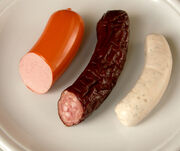
|
This page uses content from the German Wikipedia. The original article was at Brühwurst. The list of authors can be seen in the page history. As with the Sausage Wiki, the text of Wikipedia is available under Creative Commons License see Wikia:Licensing. |
Brühwurst (literally: scalded sausage) is the generic term for sausages which are produced using such methods as scalding, roasting, baking, or any other, involving heat. In contrast to Rohwurst (raw, cured sausages like salami), the muscle proteins which are contained in the sausage meat coagulate through the heat. This gives the sausage a firm enough consistency to be cut.
Brühwurst types include such sausages as Wiener and Frankfurter sausages, and all kinds of Fleischwurst (German bologna sausage) with or without non-meat flavoring additives, like Mortadella, Jagdwurst, Bierwurst, Lyoner, and Leberkäse.

Lyoner in synthetic casing, hot smoked and dried Austrian saucisson in synthetic casing, and Weisswurst in natural casing
Brühwurst contains approximately 50% meat, 25% fat, and 25% water.
In the production, lean meat and bacon are first minced in a meat grinder and, for most types, subsequently ground to an even finer degree in a so-called bowl cutter.
To prevent early coagulation, the sausage mass must be well-chilled during the whole process. To this end, ice or iced water is added. An additionally added amount of 1.5 to 2% of table salt or nitrite curing salt serves to partially dissolve the proteins and let them swell, at the same time having a preservative effect. Further additives are spices and, in most cases, substances that facilitate the fine grinding in the bowl cutter. The next steps are the filling of the ground meat mass into casings, in some cases the hot smoking, and the name-giving step — the scalding or other cooking.
For example, if scalding is the process, in this step, the sausages are heated to an internal temperature of approximately 68 °C (154 °F), at which the proteins of the muscle fibers coagulate, forming a gel.
The consistency of a Brühwurst depends on the water binding capacity of the meat, which is especially high immediately after slaughtering, so that Brühwurst is traditionally made from meat that is "still warm from slaughter."
Nowadays, predominantly cooled down or matured meat, which can only bind less water because of its lower pH value, is used. This makes necessary the addition of grinding additives. Additionally, the fat stabilization and the structure (gel) formation are critical factors for the production of Brühwurst.
According to the "Deutsche Leitsätze für Fleisch und Fleischerzeugnisse" ("German guidelines for meat and meat products"), Brühwürste can be divided roughly into four groups:
- Brühwürstchen (Wiener sausage, debrecener, Bockwurst)
- Brühwurst, fein zerkleinert (finely minced) (Lyoner, Weisswurst, Knackwurst, Leberkäse, Burenwurst)
- Grobe Brühwurst (coarsely minced Brühwurst) (Jagdwurst, Krainer sausage, Bierwurst, Krakowska)
- Brühwurst mit Einlagen (flavored Brühwurst) (Käsekrainer, Bierschinken).
"Brühwursthalbfabrikate" (semi-finished Brühwurst products) are sausages that are sold raw, but are meant to be scalded, roasted, baked, or otherwise cooked, as for example fresh Bratwurst or raw Leberkäse to bake at home.
External links[]
Tanja Nydrle (1996). "Wurst und ihre Zusatzstoffe: Entwicklung analytischer Versuche für den Einsatz in der Realschule [Sausage and its additives: development of analytical tests for the application in the Realschule (German secondary level school)"] (in German). http://www.uni-bayreuth.de/departments/ddchemie/wurst/11.htm. (Essay, University of Bayreuth).